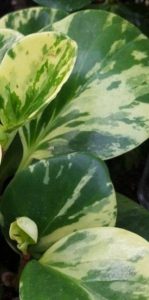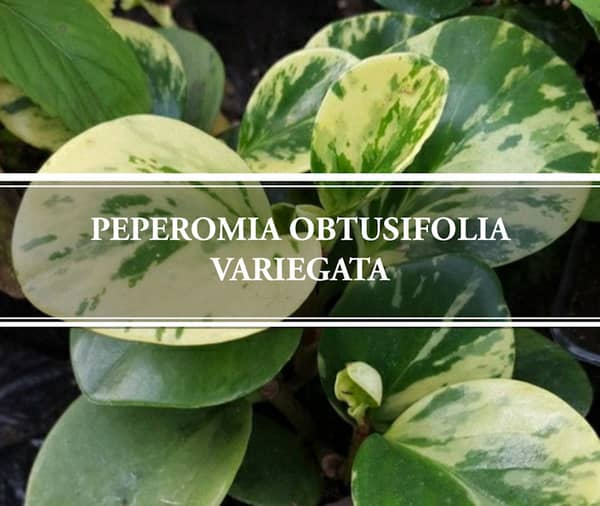Low-maintenance and resilient indoor plants with attractive foliage are always in demand. We are going to introduce the evergreen perennial epiphyte, the Peperomia obtusifolia variegata plant. This variegated form of the famous Obtusifolia originates from the Caribbean, Florida, and Mexico.
The plant gets about 30 inches long and possesses all the cherished features of the Obtusifolia, the famous baby rubber plant. The thick and fleshy cup-shaped leaves are olive green in color with speckled shades of deep green and creamy white variegations. Use it to make tabletops, pots, or decorative dishes. The attractive foliage of this compact grower is enough to decorate any indoor spot. Let us learn more about the Variegated Peperomia obtusifolia plant.
Peperomia Obtusifolia Variegata Classification
Family: Piperaceae.
Genus: Peperomia.
Species: P. obtusifolia Variegata
Common Names of the Peperomia Obtusifolia Variegata
- American Rubber Plant
- Blunt-leafed Peperomia
- Dwarf pepper
- Fleshy Peperomia
- Hanging Peperomia
- Pepper face Peperomia
- Variegated Baby Rubber Plant
Features of the Plant

Height
- This trailing plant can get about 10 to 30 inches in length and spread.
Leaves
- The leaves are thick, fleshy, and glossy.
- The size of leaves depends upon the growing conditions and genetic makeup of the individual plant. Each mature leaf can get about 3 to 7 inches in size.
Peperomia obtusifolia Variegata Flower
- The plant produces non-showy, off-white to light yellow flowers. Moreover, these flowers are about 3 inches in size and grow on long reddish-brown stems.
- Spring and summer is the blooming season.
Fragrance
Now, we are coming towards a unique and prominent feature of the Pepper Face Peperomia. The plant produces a specific maple or fenugreek-like scent. This fragrance may resemble plants like basil, chives, and oregano.
Toxicity
The Variegated Peperomia obtusifolia plant is mildly toxic in nature. So, it is better to keep kids and pets away from mingling with it.
Peperomia obtusifolia Vs. Obtusifolia Variegata
Both of these plants are pretty similar in nature and appearance. The plane foliage of the parent plant differentiates it from the Peperomia Variegata. It is simple green without any variegation.
Peperomia Obtusifolia Variegata Golden
This is another famous variety of the same parent plant. The only difference is the golden yellow variegation at the borders, adding the word Golden with its name.
Peperomia Obtusifolia Variegata Care
Peperomias are generally easy to grow plants. All they need is indirect moderate light and watering right after the soil gets about 90% dry. Let us have a detailed look at all the requirements.
Water Requirement
The thick fleshy leaves of the plant have a considerable drought tolerance. Water generously and wait for the soil to get dry. Remember, do not let the plant dry out to the point of wilting. Make sure you water right after the soil gets dry.
In summer, once a week is usually enough. On the other hand, lower temperature decreases the water requirement of the plant. Water sparingly and let it dry. About once in ten to fourteen days is enough to keep the plant alive in fall and winter.
An important part of the watering strategy is not to water the foliage. Always water the soil and avoid keeping the leaves wet. This will keep the plant safe from many serious issues.
These plants can handle under-watering but are never tolerant of over-watering. So, make sure the soil is not soggy and the plant is not standing with wet feet.
Sunlight Requirement
Bright indirect light is ideal for the plant. A place with a little exposure to a direct morning or late afternoon sun shows great results for the foliage. It has good tolerance for a variety of light levels. However, it is important to mention here that in the absence of natural light, there should be fluorescent light for compensation.
Long periods of inadequate light may lead to the loss of variegation. Moreover, the foliage will turn weak and leggy. So, it is better to avoid growing these plants in shady spots. Long-hour exposure to direct sunlight, especially the peak hours is harmful to the delicate peep.
Temperature Requirement
The evergreen variegated plant prefers a warm atmosphere. The ideal temperature range for the majority of the peperomias is 60 to 75 °F( 16 to 24 °C). Save the plant from cold winds, drifts, and temperatures below 50 °F(10 °C).
Humidity Requirement
These plants can tolerate a variety of humidity levels. Moreover, they go quite well with the average moisture level in your area. However, higher humidity is generally what they love. It is better to keep an eye on the plant on dry days. You can mist lightly to control the dryness. However, the foliage should be well-ventilated and not allowed to stay wet for long.
Soil Requirement
Well-drained soil with good aeration is ideal for this American Rubber Plant. If you are considering a DIY mixture, equal proportions of peat-moss and perlite show good results.
Fertilizer Requirement
Give a monthly dose of diluted houseplant fertilizer in spring and summer. Colder days reduce the nutritional requirements of the plant. Thus, avoid fertilizing the plant in fall and winter.
Pruning and Cutting Requirements
You can cut the older leaves and some of the branches. This will help you to maintain the size and shape of the plant.
Frequent trims to the young plants help them get a bushier look.
Pot and Repotting Requirements
These plants have small rooting systems. So, shallow pots with drainage holes at the base are ideal to grow them.
As far as repotting is concerned, you don’t need to do it frequently. Peperomias usually like to grow root-bound. So, don’t panic about repotting the plant before about two years.
Peperomia Obtusifolia Variegata Propagation
Peperomias love to grow and are easy to propagate. Common methods used for propagation include;
- Stem tip-cuttings.
- Leaf-cuttings.
Season
Warm months of spring until the middle of the summer are the ideal time to propagate.
Method
- Take a 5 to 7 inches long cutting preferably from the growing end of the stem.
- Now, remove the leaves from the lower side keeping about two to three at the top. Let it dry out for a day before planting.
- Now, dip the lower end in rooting hormone. Plant the cutting about 2 inches deeper in moist well-drained soil.
- Place the setup in a warm spot with bright indirect light. Additionally, water the soil with a spray right after the soil gets about 70% dry.
Propagation by Leaf-cuttings
- Take some leaves and cut them in half.
- Let them stay for a day to get dry. Now, plant them in moist potting mix/ soil by placing the lower ends in it.
- You can cover the pot with polythene to maintain the humidity. Alternatively, keep misting the soil right after it gets about 70% dry.
- The leaf cuttings will root out in about 3 to four weeks. You can now transfer them to individual pots.
- The pots for Peperomias should be small and shallow.
Water Propagation
These plants love to grow in water. Just dip some stem tip cuttings in a pot of water and place them in bright indirect light.
Just make sure you change the water every week or else it will get mucky. Rooting will be seen in three to four weeks followed by shoot development. You can transfer the plantlets to the soil after about two to three months. In addition, you can keep the variegated hanging Peperomia in water and enjoy it flourishing there.
Related Posts:
Problems of the Plant
The plant is generally resistant to common pest issues. This makes it an excellent choice as a houseplant. However, the plant may face certain issues due to improper care and an unsuitable environment.
Leggy Foliage
If the plant is getting sleek and leggy, inadequate light is the possible culprit. Change the place of your plant to some spot with plenty of bright indirect light. It would be great if you arrange a place with some direct morning or late afternoon sun.
Loss of Variegation
This is also a sign of inadequate light. It is better to cut the non-variegated leaves and shift the plant to suitable light.
Ring Spot
This is a dangerous virus for the plant. The leaves get distorted with necrotic or chlorotic lesions in them. If you see brown spots on the leaves and it is not due to the burning from direct sunlight, then this is the ringspot. Infected leaves will eventually fall out.
Unfortunately, this disease has no successful cure. The infected plant is immediately separated from other plants. Try cutting out the spotted leaves and see if the spotting occurs in other leaves or not. In case of severe spotting, you need to destroy/waste the plant.
Avoid higher humidity and keeping the foliage wet by misting or improper watering. In addition, make sure the plant is placed in a well-ventilated place.
Summary
Peperomia obtusifolia variegata is an evergreen perennial, popular for indoor plantation. The plant grows up to 30 inches and forms trailing bushes. The thick, fleshy, and cup-shaped leaves show a beautiful combination of greens with creamy white variegation. The Peperomia obtusifolia Variegata Care includes bright indirect light and watering after the soil gets dry.
Make sure you place it in a well-ventilated place and avoid keeping the foliage wet. The glossy thick leaves of this low-maintenance plant make it suitable for table tops, decorative dishes, and floor pots. Enjoy the beauty of this Variegated Peperomia obtusifolia, but don’t forget its mild toxicity. Keep kids and pets away to avoid any kind of health issues.

